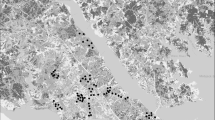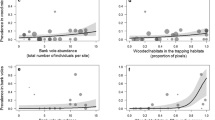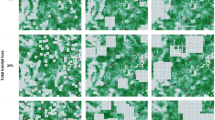Abstract
Context
In the ecology of Lyme disease emergence, it remains unclear to what extent spread of the tick vector (Ixodes scapularis) and the pathogen (Borrelia burgdorferi) are dependent upon the dispersal of vertebrate hosts in spatially heterogeneous landscapes. Yet, empirical measure of these complex ecologically driven spread processes present conceptual and methodological challenges despite important public health implications.
Objectives
To examine the relationship between landscape characteristics and tick-borne disease spread, we modeled the influence of landscape connectivity for a simplified vertebrate host community (white-footed mouse—Peromyscus leucopus, American robin—Turdus migratorius, white-tailed deer—Odocoileus virginianus) on the potential spread of the tick population compared to the pathogen in a spatially-structured landscape.
Methods
We parameterized a hybrid demographic-dispersal connectivity model by combining a series of reported host dispersal and tick burden estimates with empirically-measured tick abundance and pathogen prevalence sampled from a Lyme-endemic island landscape in Thousand Islands National Park (Ontario, Canada) and simulated several tick- and pathogen-spread scenarios.
Results
The extent of tick spread by mice [amount of reachable habitat (ARH) = 18.0%] is considerably similar to that of robins (ARH = 18.7%), while deer support the greatest tick spread extent (ARH = 82.0%). Infected mice carrying ticks support the highest pathogen spread (ARH = 19.8%). Short-distance pathogen spread and long-distance tick spread were facilitated by intermediate stepping stone habitat fragments.
Conclusions
We provide evidence that host functional connectivity mediates tick spread differently than pathogen spread, and depends strongly on landscape configuration. Our study therefore emphasizes the importance of landscape spatial heterogeneity on the ecological processes that influence regional tick-borne disease spread.





Similar content being viewed by others
Data availability
Original data used for this study were collected as part of another project and can be accessed from the original article (Werden et al. 2014). Landscape connectivity analyses were performed using Conefor, a software package freely available at www.conefor.org (Saura and Torne 2009). In particular, the Conefor version for directed graphs, as those we considered in our analyses, can be directly downloaded at http://www.conefor.org/files/usuarios/conefor_directed.zip.
References
Allan BF, Keesing F, Ostfeld RS (2003) Effect of forest fragmentation on Lyme disease risk. Conserv Biol 17:267–272
Altizer S, Dobson A, Hosseini P, Hudson P, Pascual M, Rohani P (2006) Seasonality and the dynamics of infectious diseases. Ecol Lett 9:467–484
Anderson JF, Magnarelli LA (1984) Avian and mammalian hosts for spirochete-infected ticks and insects in a Lyme disease focus in Connecticut. Yale J Biol Med 57:627
Apte S, Holland BS, Godwin LS, Gardner JP (2000) Jumping ship: a stepping stone event mediating transfer of a non-indigenous species via a potentially unsuitable environment. Biol Invasions 2:75–79
Augustine DJ, Frelich LE (1998) Effects of white-tailed deer on populations of an understory forb in fragmented deciduous forests. Conserv Biol 12:995–1004
Baguette M, Van Dyck H (2007) Landscape connectivity and animal behavior: functional grain as a key determinant for dispersal. Landscape Ecol 22:1117–1129
Baguette M, Blanchet S, Legrand D, Stevens VM, Turlure C (2013) Individual dispersal, landscape connectivity and ecological networks. Biol Rev 88:310–326
Baum KA, Haynes KJ, Dillemuth FP, Cronin JT (2004) The matrix enhances the effectiveness of corridors and stepping stones. Ecology 85:2671–2676
Bayne EM, Hobson KA (2001) Movement patterns of adult male ovenbirds during the post-fledging period in fragmented and forested boreal landscapes. Condor 103:343–351
Bélisle M (2005) Measuring landscape connectivity: the challenge of behavioral landscape ecology. Ecology 86:1988–1995
Blanchong JA, Samuel MD, Scribner KT, Weckworth BV, Langenberg JA, Filcek KB (2008) Landscape genetics and the spatial distribution of chronic wasting disease. Biol Lett 4:130–133
Bodin Ö, Saura S (2010) Ranking individual habitat patches as connectivity providers: integrating network analysis and patch removal experiments. Ecol Model 221:2393–2405
Boscolo D, Candia-Gallardo C, Awade M, Metzger JP (2008) Importance of interhabitat gaps and stepping-stones for lesser woodcreepers (Xiphorhynchus fuscus) in the Atlantic Forest, Brazil. Biotropica 40:273–276
Bouchard C, Leighton P, Beauchamp G, Nguon S, Trudel L, Milord F, Lindsay L, Bélanger D, Ogden N (2013) Harvested white-tailed deer as sentinel hosts for early establishing Ixodes scapularis populations and risk from vector-borne zoonoses in southeastern Canada. J Med Entomol 50:384–393
Clow KM, Ogden NH, Lindsay LR, Michel P, Pearl DL, Jardine CM (2016) Distribution of ticks and the risk of Lyme disease and other tick-borne pathogens of public health significance in Ontario, Canada. Vector-borne Zoonot 16:215–222
DMTI (2013) User Manual: CanMap RouteLogistics. DMTI Spatial Inc, Markham
Dwyer G, Elkinton JS (1995) Host dispersal and the spatial spread of insect pathogens. Ecology 76:1262–1275
Eisen R, Wright N (2001) Landscape features associated with infection by a malaria parasite (Plasmodium mexicanum) and the importance of multiple scale studies. Parasitology 122:507–513
ESRI. 2011 ArcMap. 10.2 ed. Redlands, California, ESRI (Environmental Systems Resource Institute)
Estrada-Peña A (2002) Understanding the relationships between landscape connectivity and abundance of Ixodes ricinus ticks. Exp Appl Acarol 28:239
Estrada-Peña A (2003) The relationships between habitat topology, critical scales of connectivity and tick abundance Ixodes ricinus in a heterogeneous landscape in northern Spain. Ecography 26:661–671
Goodwin BJ, Ostfeld RS, Schauber EM (2001) Spatiotemporal variation in a Lyme disease host and vector: black-legged ticks on white-footed mice. Vector-borne Zoonot 1:129–138
Goundie TR, Vessey SH (1986) Survival and dispersal of young white-footed mice born in nest boxes. J Mammal 67:53–60
Guerra M, Walker E, Jones C, Paskewitz S, Cortinas MR, Stancil A, Beck L, Bobo M, Kitron U (2002) Predicting the risk of Lyme disease: habitat suitability for Ixodes scapularis in the north central United States. Emerg Infect Dis 8:289
Haas CA (1995) Dispersal and use of corridors by birds in wooded patches on an agricultural landscape. Conserv Biol 9:845–854
Holmes RT, Sherry TW (2001) Thirty-year bird population trends in an unfragmented temperate deciduous forest: importance of habitat change. Auk 118:589–609
Huang ZY, van Langevelde F, Prins HH, de Boer WF (2015) Dilution versus facilitation: impact of connectivity on disease risk in metapopulations. J Theor Biol 376:66–73
Jackson LE, Hilborn ED, Thomas JC (2006) Towards landscape design guidelines for reducing Lyme disease risk. Int J Epidemiol 35:315–322
Jacquot JJ, Vessey SH (1995) Influence of the natal environment on dispersal of white-footed mice. Behav Ecol Sociobiol 37:407–412
Keesing F, Holt RD, Ostfeld RS (2006) Effects of species diversity on disease risk. Ecol Lett 9:485–498
Killilea ME, Swei A, Lane RS, Briggs CJ, Ostfeld RS (2008) Spatial dynamics of Lyme disease: a review. EcoHealth 5:167–195
Kot M, Lewis MA, van den Driessche P (1996) Dispersal data and the spread of invading organisms. Ecology 77:2027–2042
Kurtenbach K, De Michelis S, Etti S, Schäfer SM, Sewell H-S, Brade V, Kraiczy P (2002) Host association of Borrelia burgdorferi sensu lato–the key role of host complement. Trends Microbiol 10:74–79
Lacombe E, Rand PW, Smith RP (1993) Disparity of Borrelia burgdorferi infection rates of adult Ixodes dammini on deer and vegetation. J Infect Dis 167:1236–1238
Lavorel S, Gardner RH, O’Neill RV (1995) Dispersal of annual plants in hierarchically structured landscapes. Landscape Ecol 10:277–289
Leighton PA, Koffi JK, Pelcat Y, Lindsay LR, Ogden NH (2012) Predicting the speed of tick invasion: an empirical model of range expansion for the Lyme disease vector Ixodes scapularis in Canada. J Appl Ecol 49:457–464
LoGiudice K, Ostfeld RS, Schmidt KA, Keesing F (2003) The ecology of infectious disease: effects of host diversity and community composition on Lyme disease risk. Proc Natl Acad Sci USA 100:567–571
Madhav NK, Brownstein JS, Tsao JI, Fish D (2004) A dispersal model for the range expansion of blacklegged tick (Acari: Ixodidae). J Med Entomol 41:842–852
Marzluff JM, Withey JC, Whittaker KA, David OM, Unfried TM, Rullman S, DeLap J (2007) Consequences of habitat utilization by nest predators and breeding songbirds across multiple scales in an urbanizing landscape. Condor 109:516–534
May RM, Anderson RM (1984) Spatial heterogeneity and the design of immunization programs. Math Biosci 72:83–111
Meentemeyer RK, Haas SE, Vaclavik T (2012) Landscape epidemiology of emerging infectious diseases in natural and human-altered ecosystems. Ann Rev Phytopathol 50:379–402
Millins C, Gilbert L, Medlock J, Hansford K, Thompson DB, Biek R (2017) Effects of conservation management of landscapes and vertebrate communities on Lyme borreliosis risk in the United Kingdom. Phil Trans R Soc B 372:20160123
Mollison D, Anderson R, Bartlett M, Southwood R (1986) Modelling biological invasions: chance, explanation, prediction [and discussion]. Philos T Roy Soc B 314:675–693
Nadolny RM, Gaff HD (2018) Modelling the effects of habitat and hosts on tick invasions. Lett Biomath 5:2–29
Nelder MP, Russell C, Lindsay LR, Dhar B, Patel SN, Johnson S, Moore S, Kristjanson E, Li Y, Ralevski F (2014) Population-based passive tick surveillance and detection of expanding foci of blacklegged ticks Ixodes scapularis and the Lyme disease agent Borrelia burgdorferi in Ontario, Canada. PLoS ONE 9:e105358
Newman EA, Eisen L, Eisen RJ, Fedorova N, Hasty JM, Vaughn C, Lane RS (2015) Borrelia burgdorferi sensu lato spirochetes in wild birds in northwestern California: associations with ecological factors, bird behavior and tick infestation. PLoS ONE 10:e0118146
Nupp TE, Swihart RK (1996) Effect of forest patch area on population attributes of White-footed Mice (Peromyscus leucopus) in fragmented landscapes. Can J Zool 74:467–472
Ogden N, Lindsay L, Hanincová K, Barker I, Bigras-Poulin M, Charron D, Heagy A, Francis C, O’callaghan C, Schwartz. I (2008) Role of migratory birds in introduction and range expansion of Ixodes scapularis ticks and of Borrelia burgdorferi and Anaplasma phagocytophilum in Canada. Appl Environ Microbiol 74:1780–1790
Ostfeld RS, Keesing F (2000) Biodiversity and disease risk: the case of Lyme disease. Conserv Biol 14:722–728
Ostfeld RS, Canham CD, Oggenfuss K, Winchcombe RJ, Keesing F (2006) Climate, deer, rodents, and acorns as determinants of variation in Lyme-disease risk. PLoS Biol 4:e145
Porter WF, Underwood HB, Woodard JL (2004) Movement behavior, dispersal, and the potential for localized management of deer in a suburban environment. J Wildl Manag 68:247–256
Richter D, Spielman A, Komar N, Matuschka F-R (2000) Competence of American robins as reservoir hosts for Lyme disease spirochetes. Emerg Infect Dis 6:133
Rollend L, Fish D, Childs JE (2013) Transovarial transmission of Borrelia spirochetes by Ixodes scapularis: a summary of the literature and recent observations. Ticks Tick Borne Dis 4:46–51
Saura S, Torne J (2009) Conefor Sensinode 2.2: a software package for quantifying the importance of habitat patches for landscape connectivity. Environ Model Softw 24:135–139
Saura S, Bodin Ö, Fortin M-J (2014) Stepping stones are crucial for species’ long-distance dispersal and range expansion through habitat networks. J. Appl Ecol 51:171–182
Schemnitz SD (1975) Marine island: mainland movements of white-tailed deer. J. Mammal 56:535–537
Schwanz LE, Brisson D, Gomes-Solecki M, Ostfeld RS (2011) Linking disease and community ecology through behavioural indicators: immunochallenge of white-footed mice and its ecological impacts. J Anim Ecol 80:204–214
Sheppe W (1965) Island populations and gene flow in the deer mouse, Peromyscus leucopus. Evolution 19:480–495
Smith DL, Lucey B, Waller LA, Childs JE, Real LA (2002) Predicting the spatial dynamics of rabies epidemics on heterogeneous landscapes. Proc Natl Acad Sci USA 99:3668–3672
Stafford KC III, Denicola AJ, Kilpatrick HJ (2003) Reduced abundance of Ixodes scapularis (Acari: Ixodidae) and the tick parasitoid Ixodiphagus hookeri (Hymenoptera: Encyrtidae) with reduction of white-tailed deer. J Med Entomol 40:642–652
Sullivan TP (1977) Demography and dispersal in island and mainland populations of the deer mouse, Peromyscus maniculatus. Ecology 58:964–978
Telford S 3rd, Mather TN, Moore SI, Wilson ML, Spielman A (1988) Incompetence of deer as reservoirs of the Lyme disease spirochete. Am J Trop Med Hyg 39:105–109
Van Buskirk J, Ostfeld RS (1995) Controlling Lyme disease by modifying the density and species composition of tick hosts. Ecol Appl 5:1133–1140
Vellend M, Myers JA, Gardescu S, Marks PL (2003) Dispersal of trillium seeds by deer: implications for long-distance migration of forest herbs. Ecology 84:1067–1072
Wang W (2004) Population dispersal and disease spread. Discret Contin Dyn B 4:797–804
Watts EJ, Palmer SC, Bowman AS, Irvine RJ, Smith A, Travis JM (2009) The effect of host movement on viral transmission dynamics in a vector-borne disease system. Parasitology 136:1221–1234
Werden L, Barker IK, Bowman J, Gonzales EK, Leighton PA, Lindsay LR, Jardine CM (2014) Geography, deer, and host biodiversity shape the pattern of Lyme disease emergence in the Thousand Islands Archipelago of Ontario, Canada. PLoS ONE 9:e85640
Wheelwright NT, Mauck RA (1998) Philopatry, natal dispersal, and inbreeding avoidance in an island population of Savannah Sparrows. Ecology 79:755–767
With KA (2002) The landscape ecology of invasive spread. Conserv Biol 16:1192–1203
Acknowledgements
Field and laboratory work was conducted as part of another project (Werden et al. 2014) and was supported by Emily Gonzales at Thousand Islands National Park (TINP); Jeff Bowman at the Ontario Ministry of Natural Resources and Forestry (OMNRF); Ian K. Barker at the Canadian Wildlife Health Cooperative (CWHC) and Robbin Lindsay at the Public Health Agency of Canada. We thank the numerous students and staff from the OMNRF, CWHC, PHAC, and TINP who contributed to field data collection and lab work. We thank the associate editor and reviewers for their constructive comments.
Funding
M-JF was supported by NSERC Discovery Grant #5134. SS was supported by grant AGL2012-31099 from the Spanish Ministry of Economy and Competitiveness. AGW was partially supported by the University of Toronto, Department of Ecology & Evolution, and by Ontario Graduate Scholarships.
Author information
Authors and Affiliations
Corresponding author
Ethics declarations
Conflict of interest
The authors declare that there are no conflicts of interest.
Electronic supplementary material
Below is the link to the electronic supplementary material.
Rights and permissions
About this article
Cite this article
Watts, A.G., Saura, S., Jardine, C. et al. Host functional connectivity and the spread potential of Lyme disease. Landscape Ecol 33, 1925–1938 (2018). https://doi.org/10.1007/s10980-018-0715-z
Received:
Accepted:
Published:
Issue Date:
DOI: https://doi.org/10.1007/s10980-018-0715-z




